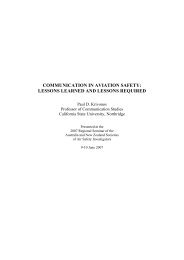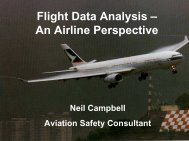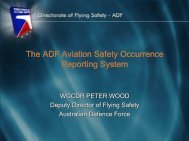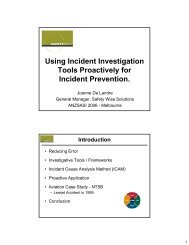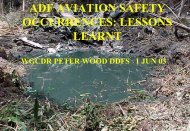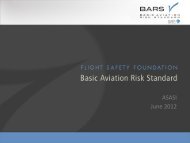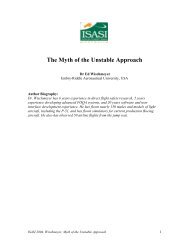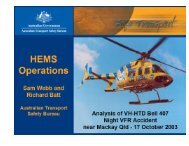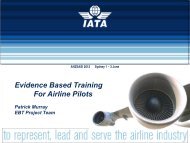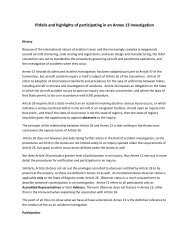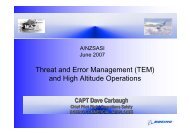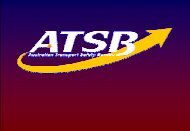Risk Approach to Night Offshore Operations Presented by ... - ASASI
Risk Approach to Night Offshore Operations Presented by ... - ASASI
Risk Approach to Night Offshore Operations Presented by ... - ASASI
You also want an ePaper? Increase the reach of your titles
YUMPU automatically turns print PDFs into web optimized ePapers that Google loves.
A <strong>Risk</strong> Management <strong>Approach</strong> <strong>to</strong><br />
Helicopter <strong>Night</strong> <strong>Offshore</strong><br />
<strong>Operations</strong><br />
Cameron Ross – Exxon Mobil<br />
Gerry Gibb – Safety Wise Solutions
Aim<br />
Through review of night offshore helicopter accidents:<br />
- Identify lessons that should have been learned<br />
- Recommend measures for accident prevention<br />
- Recommend measures for accident mitigation<br />
- Review new or emerging technology<br />
Engage Industry <strong>to</strong> provide uniform approach <strong>to</strong><br />
improve risk management night offshore applications
Background<br />
<strong>Night</strong> <strong>Offshore</strong> Medical Evacuation<br />
<strong>Night</strong> <strong>Offshore</strong> Passenger Transfer
Background<br />
<strong>Night</strong> <strong>Offshore</strong> Medical Evacuation<br />
<strong>Night</strong> <strong>Offshore</strong> Passenger Transfer<br />
<strong>Night</strong> <strong>Offshore</strong> Accidents
Terms of Reference<br />
Review of all (documented) accidents associated with<br />
night helicopter offshore 1990 - present<br />
WAAS 1990 - 2007<br />
Accident Reports – AAIB, BASI (ATSB), NTSB, FSF
Data Summary<br />
6<br />
5<br />
4<br />
3<br />
2<br />
1<br />
0<br />
1990<br />
1991<br />
1992<br />
1993<br />
1994<br />
1995<br />
1996<br />
1997<br />
1998<br />
1999<br />
2000<br />
2001<br />
2002<br />
2003<br />
2004<br />
2005<br />
2006<br />
2007<br />
<strong>Night</strong> <strong>Offshore</strong> Accidents <strong>by</strong> Year<br />
5-yr rolling<br />
average
Data Summary<br />
6<br />
5<br />
4<br />
3<br />
2<br />
1<br />
0<br />
1990<br />
1991<br />
1992<br />
1993<br />
1994<br />
1995<br />
1996<br />
1997<br />
1998<br />
1999<br />
2000<br />
2001<br />
2002<br />
2003<br />
2004<br />
2005<br />
2006<br />
2007<br />
<strong>Night</strong> <strong>Offshore</strong> Accidents <strong>by</strong> Year<br />
5-yr rolling<br />
average<br />
Highest in<br />
2007 with a<br />
positive<br />
gradient
Data Summary<br />
<strong>Night</strong> <strong>Offshore</strong> Accidents <strong>by</strong> Year<br />
6<br />
5<br />
<strong>Night</strong> Hours Flown (using 3% OGP Hrs as night)<br />
4<br />
30,000<br />
3<br />
28,000<br />
2<br />
26,000<br />
1<br />
24,000<br />
0<br />
<strong>Night</strong> Hours Flown<br />
1990<br />
1991<br />
1992<br />
1993<br />
1994<br />
1995<br />
1996<br />
1997<br />
1998<br />
1999<br />
2000<br />
2001<br />
2002<br />
2003<br />
2004<br />
2005<br />
2006<br />
2007
Data Summary<br />
<strong>Night</strong> <strong>Offshore</strong> Accidents <strong>by</strong> Year<br />
6<br />
5<br />
4<br />
3<br />
2<br />
1<br />
<strong>Night</strong> Hours Flown (using 3% OGP Hrs as night)<br />
30,000<br />
28,000<br />
26,000<br />
24,000<br />
0<br />
<strong>Night</strong> Hours Flown<br />
1990<br />
1991<br />
1992<br />
1993<br />
1994<br />
1995<br />
1996<br />
1997<br />
1998<br />
1999<br />
2000<br />
2001<br />
2002<br />
2003<br />
2004<br />
2005<br />
2006<br />
2007<br />
4 accidents in 2004: 25,800 hours flown 15.5 accidents/100K night hours
Data Summary<br />
6<br />
5<br />
4<br />
3<br />
2<br />
1<br />
0<br />
15<br />
12<br />
9<br />
6<br />
3<br />
Accidents/100K hours<br />
1990<br />
1991<br />
1992<br />
1993<br />
1994<br />
1995<br />
1996<br />
1997<br />
1998<br />
1999<br />
2000<br />
2001<br />
2002<br />
2003<br />
2004<br />
2005<br />
2006<br />
2007<br />
<strong>Night</strong> <strong>Offshore</strong> Accidents <strong>by</strong> Year<br />
Accidents per 100K night hours
Data Summary<br />
<strong>Night</strong> <strong>Offshore</strong> Accidents <strong>by</strong> Year<br />
6<br />
5<br />
4<br />
3<br />
2<br />
1<br />
Accidents per 100K night hours<br />
15<br />
12<br />
9<br />
6<br />
3<br />
0<br />
1990<br />
1991<br />
1992<br />
1993<br />
1994<br />
1995<br />
1996<br />
1997<br />
1998<br />
1999<br />
2000<br />
2001<br />
2002<br />
2003<br />
2004<br />
2005<br />
2006<br />
2007<br />
Accidents/100K hours<br />
Average <strong>to</strong> date: 8.4 Accidents/100K night hours
Data Summary<br />
6<br />
5<br />
4<br />
3<br />
2<br />
1<br />
0<br />
Accidents per 100K night hours<br />
15<br />
12<br />
9<br />
6<br />
3<br />
Accidents/100K hours<br />
1990<br />
1991<br />
1992<br />
1993<br />
1994<br />
1995<br />
1996<br />
1997<br />
1998<br />
1999<br />
2000<br />
2001<br />
2002<br />
2003<br />
2004<br />
2005<br />
2006<br />
2007<br />
<strong>Night</strong> <strong>Offshore</strong> Accidents <strong>by</strong> Year<br />
<strong>Night</strong> 8.4/100K<br />
‘OGP’ 1.6/100K
Data Summary<br />
<strong>Night</strong> <strong>Offshore</strong> Accidents <strong>by</strong> Year<br />
6<br />
5<br />
4<br />
3<br />
2<br />
<strong>Night</strong> 8.4/100K<br />
Accidents per 100K night hours<br />
15<br />
12<br />
9<br />
6<br />
1<br />
0<br />
‘OGP’ 1.6/100K<br />
3<br />
1990<br />
1991<br />
1992<br />
1993<br />
1994<br />
1995<br />
1996<br />
1997<br />
1998<br />
1999<br />
2000<br />
2001<br />
2002<br />
2003<br />
2004<br />
2005<br />
2006<br />
2007<br />
Accidents/100K hours<br />
Disproportionately more night accidents/100K hours <strong>by</strong> fac<strong>to</strong>r of >5
Why the Focus?<br />
Reality:<br />
• Industry is aiming <strong>to</strong> reduce accidents <strong>by</strong> 80% <strong>by</strong> 2016<br />
• The <strong>Night</strong> offshore accident rate and trend has <strong>to</strong> be<br />
addressed if this target is <strong>to</strong> be met.<br />
Outlook:<br />
• We have all of the information we need <strong>to</strong> effect<br />
change<br />
• The five-year average fatal accident rate/100K hours<br />
can begin <strong>to</strong> be reduced this year*<br />
• The five-year average fatal accident rate/100K hours<br />
can be reduced <strong>to</strong> zero <strong>by</strong> 2016*<br />
*............... if we make one or two changes
Root Cause Analysis<br />
Mechanical<br />
3% 3%<br />
Under Investigation<br />
Unknown<br />
29%<br />
57%<br />
Standardisation/<br />
Technique<br />
Inadvertent IMC<br />
8%
Inadvertent IMC – what went wrong<br />
5%<br />
All aircraft were conducting 3% visual operations in a<br />
night IFR environment and went IMC<br />
11%<br />
- All flown VFR <strong>to</strong> destination<br />
8%<br />
- All involved single pilot<br />
42%<br />
- No apparent use of missed approach procedures<br />
11%<br />
- No IVSI, radalt, audio alerts (AVAD)<br />
13% 8%
Inadvertent IMC – how <strong>to</strong> improve<br />
3%<br />
5%<br />
1. Accept ‘<strong>Night</strong> VFR <strong>Offshore</strong>’ as an oxymoron<br />
and a misnomer 11%<br />
FAR 135.207 VFR Helicopter Surface Reference Requirements:<br />
8%<br />
11%<br />
42%<br />
No person may operate a helicopter under VFR unless that<br />
person has visual surface reference or, at night, visual surface<br />
light reference, sufficient <strong>to</strong> safely control the helicopter.<br />
No moon, no<br />
13%<br />
stars = no horizon = IFR<br />
8%<br />
A single light source does not provide an horizon
Inadvertent IMC – how <strong>to</strong> improve<br />
11%<br />
3%<br />
5%<br />
1. Understand ‘<strong>Night</strong> VFR <strong>Offshore</strong>’ is a misnomer<br />
2. Operate with two instrument qualified crew<br />
8%<br />
3. Operate in accordance with IFR procedures<br />
42%<br />
3. Operate IFR equipped aircraft<br />
11%<br />
- IVSI’s, Radalts, AVAD, Stabilisation equipment (AFCS, Au<strong>to</strong>pilot)<br />
4. Use of Standard Operating Procedures<br />
- discussed further<br />
13% 8%
Root Cause Analysis<br />
Mechanical<br />
3% 3%<br />
Under Investigation<br />
Unknown<br />
29%<br />
57%<br />
Standardisation/<br />
Technique<br />
Inadvertent IMC<br />
8%
tandardisation / Technique – what went wrong<br />
Lack of situational awareness in the air<br />
5%<br />
Transfer from IFR <strong>to</strong> VFR and 3% back <strong>to</strong> IFR contributing fac<strong>to</strong>r. Spatial<br />
disorientation, no horizon, lack of visual cues - without disciplined<br />
procedural processes 11% <strong>to</strong> fall back on.<br />
8%<br />
42%<br />
11%<br />
13% 8%
tandardisation / Technique – what went wrong<br />
Lack of positional awareness in the air<br />
5%<br />
Transfer from IFR <strong>to</strong> VFR and 3% back <strong>to</strong> IFR contributing fac<strong>to</strong>r. Spatial<br />
disorientation, no horizon, lack of visual cues - without disciplined<br />
procedural process 11% <strong>to</strong> fall back on.<br />
Poor handling / incorrect profile flown<br />
Poor or incorrect 8% handling <strong>by</strong> the aircrew. Inadequate 42% use of au<strong>to</strong>mation<br />
and instrumentation. Incorrect profile – <strong>to</strong>o steep, <strong>to</strong>o slow, <strong>to</strong>o shallow.<br />
11%<br />
13% 8%
tandardisation / Technique – what went wrong<br />
Lack of positional awareness in the air (‘SA’)<br />
5%<br />
Transfer from IFR <strong>to</strong> VFR and 3% back <strong>to</strong> IFR contributing fac<strong>to</strong>r. Spatial<br />
disorientation, no horizon, lack of visual cues - without disciplined<br />
procedural process 11% <strong>to</strong> fall back on.<br />
Poor handling / incorrect profile flown<br />
Poor or incorrect 8% handling <strong>by</strong> the aircrew. Inadequate 42% use of au<strong>to</strong>mation<br />
and instrumentation. Incorrect profile – <strong>to</strong>o steep, <strong>to</strong>o slow, <strong>to</strong>o shallow.<br />
Omission of<br />
11%<br />
action / inappropriate action <strong>by</strong> flight<br />
crew member<br />
Failure <strong>to</strong> correctly follow procedures<br />
13% 8%
tandardisation / Technique – what went wrong<br />
Lack of positional awareness in the air (‘SA’)<br />
5%<br />
Transfer from IFR <strong>to</strong> VFR and 3% back <strong>to</strong> IFR contributing fac<strong>to</strong>r. Spatial<br />
disorientation, no horizon, lack of visual cues - without disciplined<br />
procedural process 11% <strong>to</strong> fall back on.<br />
Poor handling / incorrect profile flown<br />
Poor or incorrect 8% handling <strong>by</strong> the aircrew. Inadequate 42% use of au<strong>to</strong>mation<br />
and instrumentation. Incorrect profile – <strong>to</strong>o steep, <strong>to</strong>o slow, <strong>to</strong>o shallow.<br />
Omission of<br />
11%<br />
action / inappropriate action <strong>by</strong> flight<br />
crew member<br />
Failure <strong>to</strong> correctly follow procedures<br />
Poor crew coordination<br />
Failure in moni<strong>to</strong>ring/challenging<br />
13% 8%
Standardisation / Technique – how <strong>to</strong> improve<br />
Fixed Wing Community - Learning #1<br />
5%<br />
Disciplined Adherence 11% <strong>to</strong> Stabilised <strong>Approach</strong>es<br />
8%<br />
3%<br />
Understanding fac<strong>to</strong>rs contributing <strong>to</strong> non-stabilised approaches and have an<br />
appreciation of elements of a stabilised approach and corresponding <strong>to</strong>lerances.<br />
Use of the Go-Around for an non-stabilised approach.<br />
42%<br />
11%<br />
13% 8%
Standardisation / Technique – how <strong>to</strong> improve<br />
Fixed Wing Community - Learning #1<br />
3%<br />
5%<br />
Example of how Fixed Wing view stabilised approach<br />
11%<br />
1. The aircraft is on the correct flight path<br />
2. Small changes in heading/pitch <strong>to</strong> maintain correct flight path<br />
3. Aircraft speed 8% control (FW use of Vref + 20 indicative 42% of <strong>to</strong>lerances)<br />
4. Aircraft in correct landing configuration<br />
5. Sink rate < 1000fpm unless special briefing completed<br />
6. Power setting 11% appropriate for approach configuration<br />
7. All briefings and checklists have been completed<br />
8. <strong>Approach</strong> <strong>to</strong>lerances complied 13% with and wings level<br />
8%<br />
300’AGL<br />
9. Unique approach, or abnormal conditions, have been specially briefed
Standardisation / Technique – how <strong>to</strong> improve<br />
Fixed Wing Community - Learning #1<br />
8%<br />
11%<br />
3%<br />
5%<br />
Disciplined Adherence <strong>to</strong> Stabilised <strong>Approach</strong>es<br />
If not stabilised, executing<br />
42%<br />
the Go-Around is GOOD!<br />
11%<br />
13%<br />
8%
Standardisation / Technique – how <strong>to</strong> improve<br />
Disciplined Adherence <strong>to</strong> Stabilised <strong>Approach</strong>es<br />
5%<br />
3%<br />
Nine (9) elements of a stabilised approach. Understanding fac<strong>to</strong>rs contributing <strong>to</strong><br />
non-stabilised approaches. Knowledge of <strong>to</strong>lerances defining stabilised approach.<br />
11%<br />
Use of the Go-Around for an non-stabilised approach.<br />
Crew Coordination and Procedures<br />
8%<br />
42%<br />
Standard industry calls, briefings and procedures for offshore night approach.<br />
Standard industry criteria for when visual approach can be commenced.<br />
11%<br />
13% 8%
Standardisation / Technique – how <strong>to</strong> improve<br />
Disciplined Adherence <strong>to</strong> Stabilised <strong>Approach</strong>es<br />
5%<br />
3%<br />
Nine (9) elements of a stabilised approach. Understanding fac<strong>to</strong>rs contributing <strong>to</strong><br />
non-stabilised approaches. Knowledge of <strong>to</strong>lerances defining stabilised approach.<br />
11%<br />
Use of the Go-Around for an non-stabilised approach.<br />
Crew Coordination and Procedures<br />
8%<br />
42%<br />
Standard industry calls, briefings and procedures for offshore night approach.<br />
Standard industry criteria for when visual approach can be commenced.<br />
Hover <strong>to</strong> Forward flight 11% – offshore<br />
Go-around (Missed <strong>Approach</strong>) – offshore<br />
Loss of Airspeed - offshore<br />
Document procedures that define crew<br />
responsibilities and expectations for transition from<br />
the visual <strong>to</strong> sole reference using instruments and<br />
coordinated crew concept.<br />
13% 8%
Standardisation / Technique – how <strong>to</strong> improve<br />
Disciplined adherence <strong>to</strong> stabilised approaches<br />
5%<br />
Document procedures for transition 3% from the hover <strong>to</strong> forward flight from<br />
visual reference <strong>to</strong> sole reference using instruments and coordinated crew<br />
concept<br />
11%<br />
Crew Coordination and Procedures<br />
Document procedures 8% that define crew responsibilities<br />
42%<br />
and expectations for<br />
transition from the visual <strong>to</strong> sole reference using instruments and a<br />
coordinated crew concept.<br />
Training<br />
11%<br />
3 offshore take-off and landings every 90-days<br />
13% 8%
Standardisation / Technique – how <strong>to</strong> improve<br />
Disciplined adherence <strong>to</strong> stabilised approaches<br />
5%<br />
Document procedures for transition 3% from the hover <strong>to</strong> forward flight from<br />
visual reference <strong>to</strong> sole reference using instruments and coordinated crew<br />
concept<br />
11%<br />
Crew Coordination and Procedures<br />
Document procedures 8% that define crew responsibilities<br />
42%<br />
and expectations for<br />
transition from the visual <strong>to</strong> sole reference using instruments and a<br />
coordinated crew concept.<br />
Training<br />
+<br />
11%<br />
3 offshore take-off and landings every 90-days<br />
Procedural training (use of simula<strong>to</strong>rs, LOFT)<br />
13% 8%
Standardisation / Technique – how <strong>to</strong> improve<br />
Disciplined adherence <strong>to</strong> stabilised approaches<br />
5%<br />
Document procedures for transition 3% from the hover <strong>to</strong> forward flight from<br />
visual reference <strong>to</strong> sole reference using instruments and coordinated crew<br />
concept<br />
11%<br />
Crew Coordination and Procedures<br />
Document procedures 8% that define crew responsibilities<br />
42%<br />
and expectations for<br />
transition from the visual <strong>to</strong> sole reference using instruments and a<br />
coordinated crew concept.<br />
Training<br />
+<br />
+<br />
11%<br />
3 offshore take-off and landings every 90-days<br />
Procedural training (use of simula<strong>to</strong>rs, LOFT)<br />
13% 8%<br />
Helicopter <strong>Operations</strong> Moni<strong>to</strong>ring Program
Accident Prevention Summary (Part 1)<br />
Operate as if in an IFR 5% environment<br />
3%<br />
Two IFR qualified pilots<br />
11%<br />
IFR capable aircraft – IVSI, Radalt, AVAD, AFCS<br />
Comprehensive 8% SOP’s – Stabilised <strong>Approach</strong><br />
42%<br />
Comprehensive SOP’s – Instrument <strong>to</strong> Visual<br />
Crew trained regularly<br />
HOMP<br />
11%<br />
13% 8%
Accident <strong>by</strong> Role: 1990 - 2007<br />
Maintenance<br />
3%<br />
Cargo<br />
5%<br />
Ferry<br />
11%<br />
Marine Pilot<br />
Transfer<br />
8%<br />
42%<br />
Passenger<br />
Medevac<br />
11%<br />
Training for<br />
Medevac<br />
13%<br />
8%<br />
Training
Accident Prevention – Passenger Role<br />
Base Assumption from root cause analysis:<br />
- Dual IFR qualified pilot<br />
- IFR operation<br />
- 2 x IVSI, 2 x radalts, AVAD, AFCS<br />
Passenger<br />
-Twin turbine<br />
- TAWS, EGPWS<br />
- Adverse Weather 11% Policy<br />
- Experience & recency – aircrew<br />
- Procedures and Training<br />
13% 8%<br />
42%<br />
Training<br />
50%
Accident Prevention – Base Case<br />
3%<br />
5%<br />
Base Assumption: 11% Accident Prevention Base Case:<br />
- Twin turbine TAWS, EGPWS<br />
- Dual IFR Pilot Adverse Weather Policy<br />
- IFR operation Experience & Recency 42%<br />
- IVSI, Radalt, AFCS Procedures and Training<br />
11%<br />
13%<br />
8%
Accident Prevention – <strong>Offshore</strong> Medevac<br />
Base Assumption: Accident Prevention Base Case:<br />
5%<br />
- Twin turbine 3% TAWS, EGPWS<br />
- Dual IFR Pilot Adverse Weather Policy<br />
11%<br />
- IFR operation Experience & Recency<br />
- IVSI, Radalt, AFCS Procedures and Training<br />
+<br />
Medevac<br />
24%<br />
11%<br />
Training for<br />
Medevac<br />
13%<br />
- <strong>Risk</strong> Assessment<br />
42%<br />
Involve client organisation, aircraft<br />
opera<strong>to</strong>r and Company medical and<br />
aviation expertise.<br />
- Company Guidelines<br />
Based on <strong>Risk</strong> Assessment develop<br />
guidance with call-out pro<strong>to</strong>col and<br />
high level management endorsement.<br />
8%<br />
<strong>Night</strong> medevac for life threatening<br />
situations only.
Accident Prevention – Marine Pilot Transfer<br />
‘<strong>Night</strong> Visual Flight 5% Rules (VFR) <strong>Offshore</strong>’ is a<br />
3%<br />
misnomer and an oxymoron<br />
11%<br />
Marine Pilot<br />
Transfer<br />
8%<br />
8%<br />
42%<br />
11%<br />
Dark night, no horizon, offshore = IFR environment<br />
MPT should be considered<br />
13%<br />
no<br />
8%<br />
different than the<br />
offshore passenger role
Accident Prevention - Non-Passenger<br />
19%<br />
Maintenance<br />
3%<br />
Ferry<br />
11%<br />
Cargo<br />
5%<br />
3 Standardisation / Technique<br />
1 Inadvertent IMC<br />
3 Unknown<br />
No maintenance flights at night<br />
No cargo flights at night<br />
No ferry/re-positioning at night
Accident Prevention Summary (Part 2)<br />
Operate as if in an IFR environment<br />
Two IFR qualified and regularly trained 5% pilots<br />
3%<br />
IFR capable aircraft – IVSI, Radalt, AVAD<br />
Trained using comprehensive 11% SOP’s – Stabilised <strong>Approach</strong><br />
Trained using comprehensive SOP’s – Instrument <strong>to</strong> Visual<br />
HOMP<br />
Twin turbine<br />
TAWS, EGPWS<br />
8%<br />
Adverse Weather Policy<br />
Experience and recency 11%<br />
Aircrew procedures and training<br />
Accident reports tell 42% us majority of<br />
accidents would not have occurred if<br />
these controls and error traps were<br />
in place and effective<br />
Medevac Policy in place for life threatening situations only<br />
13% 8%<br />
No maintenance flights, cargo or ferry flights at night<br />
Marine Pilot Transfer be treated the same as night offshore passenger flights
Accident Mitigation<br />
Base Assumption: Accident Prevention:<br />
- Twin turbine TAWS, EGPWS<br />
- Dual Pilot Adverse Weather Policy<br />
- IFR operation Experience & Recency<br />
- IVSI, 2 x radalts Procedures and Training<br />
Passenger<br />
- HUET, HEELS, Survival Suits A/R<br />
42%<br />
8%<br />
50%<br />
Training
Accident Mitigation<br />
Base Assumption: Accident Prevention:<br />
- Twin turbine TAWS, EGPWS<br />
- Dual Pilot Adverse Weather Policy<br />
- IFR operation Experience & Recency<br />
- IVSI, 2 x radalts Procedures and Training<br />
Passenger<br />
- HUET, HEELS, Survival Suits<br />
42%<br />
- Au<strong>to</strong>matic Float Inflation<br />
8%<br />
50%<br />
Training
Accident Mitigation<br />
Base Assumption: Accident Prevention:<br />
- Twin turbine TAWS, EGPWS<br />
- Dual Pilot Adverse Weather Policy<br />
- IFR operation Experience & Recency<br />
- IVSI, 2 x radalts Procedures and Training<br />
Passenger<br />
- HUET, HEELS, Survival Suits<br />
42%<br />
- Au<strong>to</strong>matic Float Inflation<br />
- External Liferafts<br />
8%<br />
50%<br />
Training
Accident Mitigation<br />
Base Assumption: Accident Prevention:<br />
- Twin turbine TAWS, EGPWS<br />
- Dual Pilot Adverse Weather Policy<br />
- IFR operation Experience & Recency<br />
- IVSI, 2 x radalts Procedures and Training<br />
Passenger<br />
- HUET, HEELS, Survival Suits<br />
42%<br />
- Au<strong>to</strong>matic Float Inflation<br />
- External Liferafts<br />
- Adverse Weather Policy<br />
8%<br />
Training<br />
50%
Accident Mitigation<br />
Base Assumption: Accident Prevention:<br />
- Twin turbine TAWS, EGPWS<br />
- Dual Pilot Adverse Weather Policy<br />
- IFR operation Experience & Recency<br />
- IVSI, 2 x radalts Procedures and Training<br />
Passenger<br />
- HUET, HEELS, Survival Suits<br />
42%<br />
- Au<strong>to</strong>matic Float Inflation<br />
- External Liferafts<br />
- Adverse Weather Policy<br />
- SAR Review<br />
8%<br />
Training<br />
50%
Accident Mitigation<br />
Base Assumption: Accident Prevention:<br />
- Twin turbine TAWS, EGPWS<br />
Passenger<br />
- Dual Pilot Adverse Weather Policy<br />
- IFR operation Experience & Recency<br />
- IVSI, 2 x radalts Procedures and Training<br />
- HUET, HEELS, Survival Suits<br />
- Au<strong>to</strong>matic Float Inflation<br />
42%<br />
- External Liferafts<br />
- Adverse Weather Policy<br />
- SAR Review<br />
- Satellite Flight Following<br />
8%<br />
Training<br />
50%
Accident Prevention and Mitigation Summary<br />
Operate as if in an IFR environment<br />
Two IFR qualified pilots, trained regularly 5%<br />
3%<br />
IFR capable aircraft – IVSI, Radalt, AVAD<br />
Comprehensive SOP’s 11% – Stabilised <strong>Approach</strong><br />
Comprehensive SOP’s – Instrument <strong>to</strong> Visual<br />
HOMP<br />
8%<br />
Twin turbine<br />
TAWS, EGPWS<br />
Adverse Weather Policy<br />
Experience and recency 11%<br />
Aircrew procedures and training<br />
20<br />
HUET, HEELS, Survival Suits A/R<br />
Au<strong>to</strong>matic float inflation<br />
External liferafts 42%<br />
Adverse Weather Policy<br />
SAR capability<br />
Satellite flight following<br />
Medevac Policy in place for life threatening situations only<br />
13% 8%<br />
No maintenance flights, cargo or ferry flights at night<br />
Marine Pilot Transfer be treated the same as night offshore passenger flights
Accidents <strong>by</strong> Location: 1990 - 2007<br />
GOM 32%<br />
China<br />
Europe<br />
5%<br />
11%<br />
Africa<br />
11%<br />
8%<br />
32%<br />
5%<br />
5%<br />
UK<br />
Netherlands<br />
GOM<br />
Norway 0<br />
Canada 0<br />
North Sea 10%<br />
Australia
Accidents <strong>by</strong> Location: 1990 - 2007<br />
GOM 32%<br />
Best Practices<br />
China<br />
Europe<br />
5%<br />
11%<br />
Africa<br />
11%<br />
8%<br />
32%<br />
5%<br />
5%<br />
UK<br />
Netherlands<br />
GOM<br />
Canada 0<br />
Norway 0<br />
North Sea 10%<br />
Australia
Accidents <strong>by</strong> Location: 1990 - 2007<br />
GOM 32%<br />
Best Practices<br />
China<br />
Europe<br />
5%<br />
11%<br />
Africa<br />
11%<br />
8%<br />
32%<br />
5%<br />
5%<br />
UK<br />
Netherlands<br />
GOM<br />
Canada 0<br />
Norway 0<br />
North Sea 10%<br />
20<br />
Australia
Available technology <strong>to</strong> be pursued<br />
Enhanced Vision Systems (EVS)<br />
Operational in fixed wing<br />
11%<br />
Synthetic Vision<br />
Flying in a helicopter <strong>to</strong>day<br />
3%<br />
5%<br />
8%<br />
Platform Visual Landing Systems<br />
42%<br />
Recommended in accident reports and ICAO documents<br />
11%<br />
Helideck Lighting Systems<br />
13% 8%<br />
Thames Alpha Phase Two trials
Technology – Enhanced Vision Systems<br />
11%<br />
3%<br />
8%<br />
42%<br />
11%<br />
13% 8%
Technology – Synthetic Vision<br />
3%<br />
5%<br />
11%<br />
8%<br />
42%<br />
11%<br />
13% 8%
Technology - Visual Landing Systems<br />
ICAO Heliport Manual 5% 3 rd Edition 1995<br />
“A single unit indica<strong>to</strong>r, known as the Helicopter <strong>Approach</strong> Path<br />
Indica<strong>to</strong>r (HAPI) should 11% be installed at an elevated heliport or helideck<br />
where there is the need <strong>to</strong> provide approach slope guidance<br />
visually....”<br />
8%<br />
42%<br />
“The HAPI system is closely associated with the safety of helicopter<br />
operations....”<br />
11%<br />
Australian BASI Report B/915/1020 SA330J 12/5/1991<br />
Install visual aid for night offshore approaches <strong>to</strong> offshore platforms<br />
13% 8%
PLASI-2000<br />
HELICOPTER<br />
PULSE LIGHT APPROACH SLOPE INDICATORS<br />
INCREASING OFF SHORE<br />
HELIDECK SAFETY<br />
HAPI-PLASI<br />
PLASI
Technology - Visual Landing Systems<br />
HAPI-PLASI Signal Format<br />
Above Course<br />
On Course<br />
Below Course<br />
Well Below Course
Technology Visual Landing Systems<br />
HELIVAS<br />
Technical Specification<br />
Stabilised Glide Slope Indica<strong>to</strong>r (SGSI)<br />
11%<br />
3%<br />
5%<br />
BEAM GEOMETRY<br />
AGI Thinks Quality<br />
8%<br />
1º wide command sec<strong>to</strong>r provides optimum guidance<br />
without being over restrictive<br />
42%<br />
11%<br />
2 º wide command sec<strong>to</strong>r allows high rates of<br />
decent <strong>to</strong> build up before corrective signal is<br />
observed.<br />
2 º is <strong>to</strong> compensate for poor stabilisation<br />
• The Red Sec<strong>to</strong>r should not hit the sea and high approach sec<strong>to</strong>r should<br />
not allow a high rate of decent <strong>to</strong> build up<br />
• NVG sec<strong>to</strong>r frequencies 0.7Hz upper, 3.9Hz lower, command sec<strong>to</strong>r<br />
steady<br />
• Colour transition between sec<strong>to</strong>rs < 3arc minutes, 1.8m @ 2km<br />
AGI have built an SGSI system for the US with additional NVG<br />
capability incorporated, as an optional extra <strong>to</strong> their standard<br />
format. This will allow them <strong>to</strong> change from a standard<br />
approach <strong>to</strong> NVG approach at the flick of a switch.<br />
13% 8%<br />
back<br />
next<br />
www.agiltd.co.uk
Technology - Helipad Lighting Systems<br />
3%<br />
5%<br />
11%<br />
8%<br />
42%<br />
11%<br />
13% 8%
OGP <strong>Approach</strong> <strong>to</strong> <strong>Night</strong> <strong>Offshore</strong> <strong>Operations</strong><br />
Reaffirmation of current ‘base case’<br />
1) Two pilot, twin engine IFR operation, IVSI, 2 radalts, AVAD, au<strong>to</strong>pilot<br />
2) 3 offshore deck landings every 90-days or suitable equivalent<br />
3) TAWS/EGPWS, HUET and Adverse Weather Policy<br />
Accident Prevention - Mandate<br />
6) Pilot experience – Captains 25 hours night offshore<br />
7) Focus on offshore night training syllabus of Opera<strong>to</strong>rs<br />
8) Develop localised Medevac Guidance based on RA<br />
and with appropriate senior management endorsement<br />
9) HOMP<br />
Instrument <strong>to</strong> Visual<br />
Stabilised <strong>Approach</strong>es<br />
Documented procedures<br />
Accident Mitigation – Mandate<br />
10) HEEL, Au<strong>to</strong>matic float inflation, External life-rafts<br />
11) SAR review and RA<br />
12) Satellite flight following<br />
Pursuit of New Technology<br />
13) Enhanced Vision, synthetic vision<br />
14) Helideck visual approach indica<strong>to</strong>rs and helipad lighting – pursue trials
OGP Consideration<br />
Safety Moni<strong>to</strong>ring – Low Workload (and should diminish)<br />
1) Continue <strong>to</strong> track night offshore accidents. Using sub-group approach reach<br />
consensus on additional subjective analysis associated with causal fac<strong>to</strong>rs.<br />
Procedural – Medium Workload<br />
2) Work with opera<strong>to</strong>rs (Bris<strong>to</strong>w, CHC, Cougar, PHI et al) + industry (EHOC,<br />
HSAC) <strong>to</strong> assist industry in producing guidance paper on standardised night<br />
offshore procedures and training syllabus.<br />
Technology – Medium Workload<br />
3) Work with OEM’s <strong>to</strong> impart necessity for external life-raft, au<strong>to</strong>matic floatation,<br />
emergency exit lighting <strong>to</strong> be an offshore standard.<br />
4) Work with OEM and opera<strong>to</strong>rs on progressing vision technology and GPI’s<br />
Trial – Medium workload <strong>by</strong> OGP ASC <strong>to</strong> coordinate and sponsor<br />
5) Fixed and floating GPI procedures for industry<br />
6) Procedural commonality for industry
<strong>Risk</strong> Based <strong>Approach</strong><br />
How can we use this data 5% in a meaningful way?<br />
Educate non aviation management<br />
11%<br />
Conduct <strong>Risk</strong> assessment<br />
Develop industry wide risk assessment ‘<strong>to</strong>ol-kit’<br />
Scenarios based<br />
8%<br />
on all data reviewed<br />
42%<br />
Prevention and Mitigation based on accident reports<br />
What would 11% that <strong>to</strong>ol-kit look like?<br />
13% 8%
<strong>Night</strong> Flight <strong>Risk</strong> Assessment
Thank you<br />
Any Questions ?<br />
Gerry.Gibb@safetywisesolutions.com<br />
www.safetywisesolutions.com



